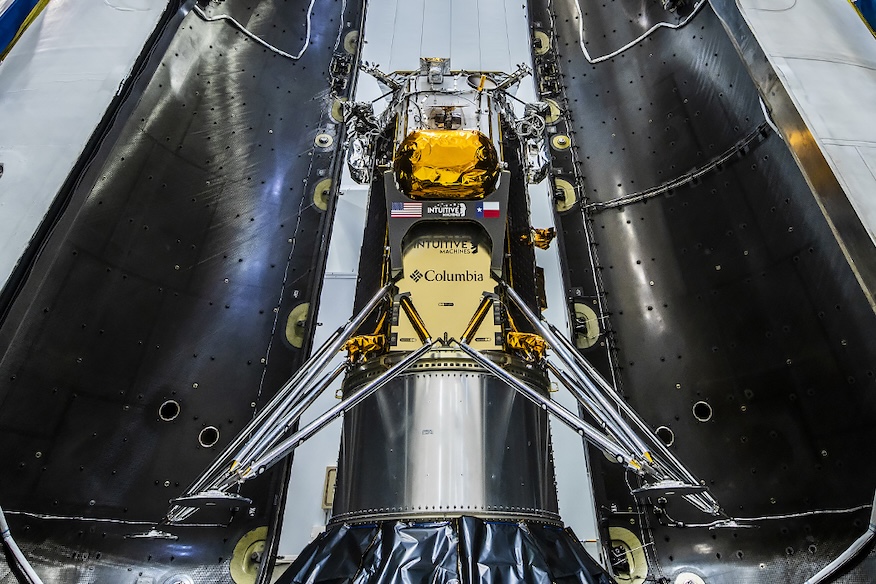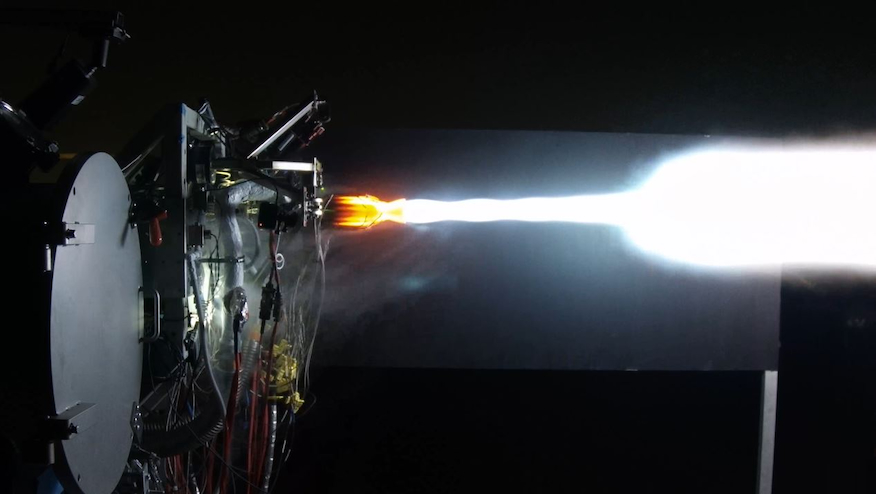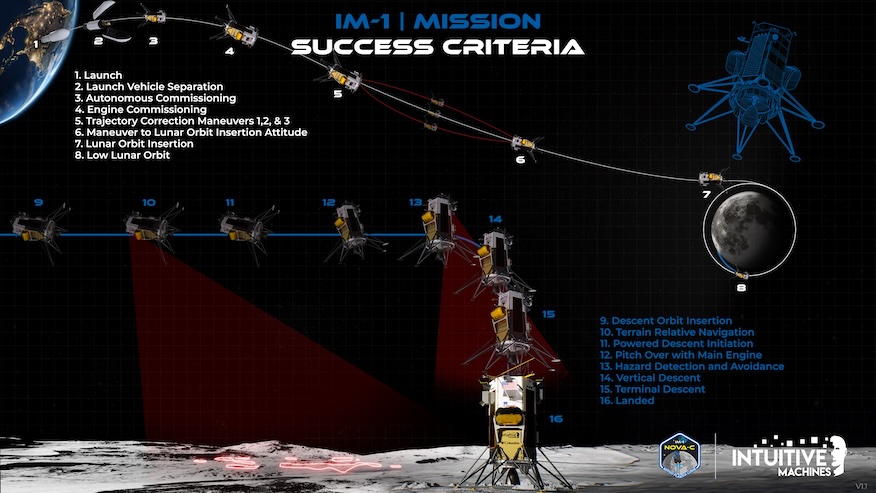
Update 11:05 p.m. EST: SpaceX and Intuitive Machines scrubbed the launch attempt for Wednesday morning.
A launch pad billed as the Apollo program’s “Moonport” is once again preparing to send off a mission bound for the Moon. More than 50 years after Apollo 17, SpaceX’s Falcon 9 rocket aims to launch Intuitive Machines’ robotic Nova-C lander, named Odysseus, on a lunar journey Wednesday morning.
The mission, dubbed IM-1, has a 15-second launch window that opens at 1:05 a.m. EST (0605 UTC) at Launch Complex 39A. It will kick off a roughly eight-day journey to the Moon, culminating in a landing late in the day on Feb. 22.
IM-1 will be the second flight for NASA’s Commercial Lunar Payload Services (CLPS) program. NASA purchased space for six scientific instruments at a cost of just under $118 million. The agency spent about $11 million to design and build the instruments.
Among those are cameras that will help create a 3D rendering of the dust kicked up at landing, a tech demonstration that will help with future landing accuracy and sensor that uses radio waves to detect how much propellant is inside the lander.
Spaceflight Now will have live coverage of the mission about 2 hours ahead of liftoff.
[embedded content]
Ahead of the launch, Spaceflight Now and CBS News jointly spoke with Steve Altemus, the CEO of Intuitive Machines about reaching this milestone after years of work and planning. During his time working at NASA’s Kennedy Space Center, he held a number of positions within the Space Shuttle Program, especially concerning launch and landing.
“Every time before I launched the Space Shuttle, I would spend some quiet time with the rocket, the tank and the orbiter and get one with the shuttle and listen to it and talk to it and feel the energy of the machine,” Altemus said. “I wanted to do that here and coming full circle back to Pad A and see the Falcon 9 5500 sitting there with our Nova-C, Odie lander, the nickname of our lander on top, I just wanted to be there with it and get a sense of it.”
The pad was specially outfitted by SpaceX to support this mission. The lander is fueled by liquid methane and liquid oxygen (LOX), a departure from the kerosene and LOX-fueled Falcon 9 rocket.
This past Thursday and Saturday, SpaceX and Intuitive Machines performed a series of fueling tests, known as wet dress rehearsals, where they tweaked the timing of propellant load to be most ideal for the lander. Because the Nova-C lander uses cryogenic fuel, its tanks need to be filled close to liftoff.
Altemus described Thursday’s test as “quite a feat” that went successfully the first time. He said they performed a second test on Saturday in order to make sure they had the timing where they wanted it.
During that test, Altemus said there were some “minor ground support equipment leaks” with both the methane and LOX side, but the LOX leak didn’t require repairs.
During a prelaunch briefing, Bill Gerstenmaier, the vice president of Build and Flight Reliability at SpaceX, said that the two companies worked closely together, both at the Cape as well as in Houston, Texas, to reduce risk on this new fueling capability.
“To be part of the lunar program and to be part of an activity taking these payloads to the surface of the Moon, which will actually help in the Artemis program in the future, is a tremendous honor for us at SpaceX,” Gerstenmaier said. “We wanted to give it our best, so we worked as hard as we can with Intuitive Machines to buy down all the risk we can and we’ll see how much our hard work pays off as we go.”

About three hours before liftoff, teams will start loading the roughly 1,200 kg of propellant onto the lander. Once fueled, the lander weighs about 2,030 kg. The ratio of LOX to liquid methane is 2.3 to 1, according to Intuitive Machines.
“SpaceX put a LOX and a methane tank just dedicated to filling the lander itself and then they fill from other dewars for their RP-1 (kerosene) and LOX for their vehicle,” Altemus said.
Unlike fueling the Falcon 9 rocket, Artemus said the Nova-C lander has the ability to hold the fueling process and “just let the tanks lock up with their sub-cold temperatures.”
“They might get to boil off before we actually lift off, but we can hold and our planned hold is about 45 minutes for the LOX and the methane before we lift off,” Altemus said.
He described “sub-cooled” as the point at which the LOX reaches about -300 degrees Fahrenheit and the methane reaches about -280 degrees.
“What will happen is that’s densified and it serves to provide more energetic propulsion on the way out to the Moon,” Altemus said. “Better mixture, better energy out of the propellants, if they’re sub-cooled.”
Trent Martin, the vice president of Space Systems for Intuitive Machines, added that fueling wraps up about an hour before launch, giving them about 20 minutes to ensure that they’re satisfied with the fill level and the temperatures of the cryogenics before the start of propellant load on the Falcon 9.
“And then just about 10 minutes or so before launch, we seal up the system and lock it off and it’s ready for launch,” Martin said. “It’s a choreography that has been rehearsed now a couple of times.”
Intuitive Machines has three, instantaneous launch windows over three days. The March window is predominantly the same, with those dates being March 14-16.
Path to the Moon
Following spacecraft separation about 48 minutes after liftoff, teams with Intuitive Machines will go through the process of acquiring the signal from the lander and begin the process of initial checkouts. About 18 hours after that, the lander performs a brief, but important test burn of the main engine called a “commissioning burn.” Martin described it as a “critical step” before they can move through the rest of the mission.
“We have to prove that that engine actually functions in the vacuum of space. We’ve never been able to do that because we haven’t been in space,” Martin said.
He noted that they have tested the igniter in a vacuum environment, which proved successful. Martin said because no other company has launched a methalox engine in deep space, they don’t have any precedent to lean upon.
“So, when we get to that point, we light that engine, we burn it for a short duration, just to prove that the engine can light and fire,” Martin said. “It does take the stress level down a little bit and brings the probability of success up a little bit.”

The choice of a methalox-fueled lander was because Intuitive Machines believes “it’s the future of this technology,” Martin said. He noted that the company performed more than 150 test firings on dozens of iterations of the main engine that powers the Nova-C lander.
“We’ve taken the engine that’s sitting on that spacecraft, with that spacecraft, and fired it as a test fire to prove that that engine will light on the vehicle,” Martin said. “We’ve done multiple filling operations to prove that we can fill with liquid oxygen and liquid methane and we can flow them at the right rates and ignite them at the right time. And we’ve been able to test the throttle ability of the engine.
“That’s extremely important because as you go to land on the surface of the Moon, you’re going to lose two-thirds of the mass that you started with. You’re going to lose it as you burn it up. So, you have to be able to throttle back that engine to a much lower level than the 100 percent that you started with.”
Once the lander completes the engine commissioning, there are up to three trajectory correction maneuvers that are short firings of just a second or two. That’s followed by the lunar orbit insertion (LOI) burn, which lasts about seven minutes.
The lander will then fly in a circular, low lunar orbit (LLO) of 100 kilometers above the Moon’s surface for about 24 hours, which is followed by the descent orbit insertion (DOI), which comes about 75 minutes ahead of landing.
The DOI coast to the powered descent initiation (PDI) is about an hour, setting up a roughly 15-minute burn through landing. During that process, the lander will shift from a horizontal position to a vertical one. Martin said having an engine that throttles for the final burn helps give them confidence in this final phase of the mission.
He said during the acceptance testing of the engine powering the Nova-C lander, it performed the entire set of burns that it will be expected to execute during the mission.
“Being able to take that engine and run it that entire time means that you never turn your engine off. So, you never have that fear that it is going to light the next time because it’s lit and it stays lit all the way to the surface,” Martin said. “And that’s what makes the technology that we’re flying different than some of our competitors have.”

Building a lunar economy
Onboard Odysseus are 12 total payloads: six commercial and six from NASA as part of its Commercial Resupply Services (CLPS) program. On the commercial side, they have a student-built camera system on a CubeSat, called EagleCam that will jettison from the lander and capture images of its descent and landing.
EagleCam was created by Embry-Riddle Aeronautical University, the alma mater of Altemus, as a response to a challenge by the founder of Intuitive Machines.
It’s almost time to witness a moon landing like the world has never seen before! 🌕 🦅
EagleCam will take the first third-person images of a lunar lander touching down on the moon.
Learn more about EagleCam: https://t.co/BCX9ivdtdw#ERAUtotheMoon #GoERAU @int_machines pic.twitter.com/SUJ8IDbCQG
— ERAU Office of Alumni Engagement (@ERAU_Alumni) February 5, 2024
Another partnership comes in the form of some of the insulation material on Odysseus, which is provided by Columbia Sportswear.
“When you see pictures of the lander now, you’ll see our Omni-Heat Infinity material on that panel protecting primarily by reflecting sunlight, but also mitigating thermal emission from the spacecraft,” Haskell Beckham, the vice president of innovation at Columbia Sportswear. “And it’s exactly the same material that we have in our jackets.”
The launch of Odysseus comes just over a month after the failed flight of Pittsburgh-based Astrobotic’s Peregrine lander. It encountered an issue with its propulsion system that force it to return to Earth for a crash landing in the Pacific Ocean.
This next lunar lander aims to not only lander closer to the Moon’s South Pole than any other previous mission, but also to become the first commercially-build lunar lander to safely touch down on the surface.
Landers from Israel and Japan preceded Peregrine in failing to reach that mark. Even on the governmental side, only the U.S., Russia, China, India and Japan have safely put landers on the Moon, though the recent “SLIM” lander from Japan tipped over after landing and had to end its mission early.
Joel Kearns, NASA’s deputy associate administrator for Exploration in the Science Mission Directorate, said that the agency is “more risk tolerant with this approach” to getting their science to the Moon’s surface.
“We’re going to be watching the attempts from all our CLPS providers and then, making decisions based on that about how we see going forward,” Kearns said. “We are committed to this model. We think that private-public partnership are the right thing to do to further exploration to space.
“We would really like to be a position where if companies could do what they told us years ago they could do, which is we could just buy the service, we would much rather buy the service than do things internally every time we do a mission at NASA, particularly to a place where there’s so much interest, like the lunar surface.”
Prior to the launch of NASA’s PACE (Plankton, Aerosol, Cloud, ocean Ecosystem) mission last week, Dr. Nicola Fox, the SMD associate administrator, said the agency was accepting of a 50 percent success rate with the CLPS program, arguing that lessons will be learned from these early missions, whether they land on the Moon successfully or not.
“We wish them God speed to the lunar surface, but if it doesn’t go totally as planned, we will learn lots and lots of lessons from that and we know the company will roll that forward into the next lunar lander attempt,” Fox said.

- SEO Powered Content & PR Distribution. Get Amplified Today.
- PlatoData.Network Vertical Generative Ai. Empower Yourself. Access Here.
- PlatoAiStream. Web3 Intelligence. Knowledge Amplified. Access Here.
- PlatoESG. Carbon, CleanTech, Energy, Environment, Solar, Waste Management. Access Here.
- PlatoHealth. Biotech and Clinical Trials Intelligence. Access Here.
- Source: https://spaceflightnow.com/2024/02/13/live-coverage-spacex-intuitive-machines-to-launch-falcon-9-rocket-on-moon-bound-mission/



